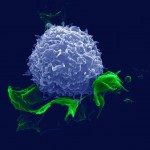Link to Pubmed [PMID] – 17456871
Radiology 2007 May;243(2):467-74
PURPOSE: To label human monocytes with superparamagnetic iron oxide (SPIO) and compare labeling efficiency with that of ultrasmall SPIO (USPIO) and evaluate the effect of iron incorporation on cell viability, migratory capacity, and proinflammatory cytokine production.
MATERIALS AND METHODS: The study was approved by the institutional ethics committee; informed consent was obtained from donors. Freshly isolated human monocytes were labeled with iron particles of two sizes, USPIOs of 30 nm and SPIOs of 150 nm, for 1.5 hours in culture medium containing 0.1, 0.5, 1.0, and 3.7 mg of iron per milliliter. Labeling efficiency was determined with relaxation time magnetic resonance (MR) imaging (4.7 T) and Prussian blue staining for presence of intracellular iron. Cell viability was monitored; migratory capacity of monocytes after labeling was evaluated by using an in vitro assay with monolayers of brain endothelial cells. Levels of proinflammatory cytokines, interleukin (IL) 1 and IL-6, were measured with enzyme-linked immunosorbent assay 24 hours after labeling. Data were analyzed with Student t test or two-way analysis of variance followed by a multiple-comparison procedure.
RESULTS: R2 relaxation rates increased for cell samples incubated with SPIOs, whereas rates were not affected for samples incubated with highest concentration of USPIOs. Labeling monocytes with SPIOs (1.0 mg Fe/mL) resulted in an R2 of 13.1 sec(-1) +/- 0.8 (standard error of the mean) (7 sec(-1) +/- 0.2 for vehicle-treated cells, P < .05) and had no effect on cell viability. On the basis of T2 relaxation times, the in vitro MR detection limit of 58 labeled monocytes per 0.05 microL was calculated. Migration of labeled monocytes was not different from that of vehicle-treated cells. Intracellular iron had no effect on production of IL-1 and IL-6 24 hours after labeling.
CONCLUSION: In vitro labeling of human monocytes is effective by using SPIOs, not USPIOs. Incubation with SPIOs (1.0 mg Fe/mL) results in efficient labeling detectable on MR images and does not affect cellular viability and activation markers such as cell migration and cytokine production.

